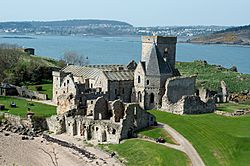Inchcolm Abbey facts for kids

Photograph, 9 April 2011
|
|
| Monastery information | |
|---|---|
| Order | Augustinian |
| Established | 1147 x 1169 (priory)/ 1235 (abbey) |
| Disestablished | 1609 |
| Diocese | Diocese of Dunkeld |
| Controlled churches | Aberdour; Auchtertool; Beath; Dalgety; Dollar; Leslie; Rosyth |
| People | |
| Founder(s) | David I of Scotland & Gregoir, Bishop of Dunkeld |
| Important associated figures | Walter Bower |
Inchcolm Abbey is a fascinating old monastery located on the small island of Inchcolm. This island sits in the Firth of Forth, a large bay in Scotland. The Abbey was built a very long time ago, in the 12th century.
It started as a smaller religious community called a priory, run by Augustinian monks. Later, in 1235, it became a full abbey. There's a story that King Alexander I of Scotland once took shelter on Inchcolm in 1123 after a storm forced his ship ashore. He supposedly stayed with a hermit there for three days.
Because of its important location, the island and Abbey were often attacked by English forces starting in 1296. The Abbey stopped being a monastery in 1560 during a big change in religion called the Scottish Reformation. Since then, it has been used for defense.
Above the Abbey's entrance, there's a Latin message carved into the stone. It means: "Still may these turrets lift their heads on high, Nor e’er as crumbling ruins strew the ground, Until an ant shall drink the ocean dry, And a slow tortoise travel the world round." This poetic message suggests the Abbey should stand forever!
Inchcolm Abbey is special because it has the most complete remains of any old monastery in Scotland. You can still see the cloisters (covered walkways), the chapter house (where monks met), the warming house, and the refectory (dining hall). Most of the other buildings are also very well preserved.
Today, Historic Environment Scotland looks after the ruins. They also have a visitor centre near the pier. You can take a ferry from South Queensferry to visit this amazing historical site. One famous person who lived here was Walter Bower, a writer from the 15th century.
The Inchcolm Antiphoner
The Abbey also gives its name to a special old book from the 14th century called the Inchcolm Antiphoner. This book contains rare examples of Celtic Plainchant, which is a very old style of religious singing.
You can even see pages from this Antiphoner online through the University of Edinburgh. The book has many chants dedicated to Saint Columba. Experts believe Inchcolm Abbey is the most likely place where this important manuscript was put together.
Inchcolm Abbey in Stories
Inchcolm Abbey has even appeared in famous stories!
- The famous writer William Shakespeare mentioned Inchcolm Abbey in his play Macbeth, written in 1606.
- William Clinkenbeard wrote a novel called The Battle of Incholm Abbey in 2012.
See also
- Abbot of Inchcolm, for a list of the leaders of the community
- Walter Bower, a famous abbot from Inchcolm
- Abbeys and priories in Scotland, for a general list of Scottish monasteries

